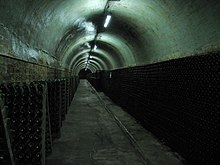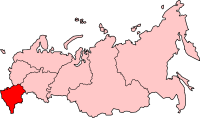
Chardonnay is a green-skinned grape variety used in the production of white wine. The variety originated in the Burgundy wine region of eastern France, but is now grown wherever wine is produced, from England to New Zealand. For new and developing wine regions, growing Chardonnay is seen as a 'rite of passage' and an easy entry into the international wine market.

A vineyard is a plantation of grape-bearing vines, grown mainly for winemaking, but also raisins, table grapes and non-alcoholic grape juice. The science, practice and study of vineyard production is known as viticulture. Vineyards are often characterised by their terroir, a French term loosely translating as "a sense of place" that refers to the specific geographical and geological characteristics of grapevine plantations, which may be imparted to the wine itself.
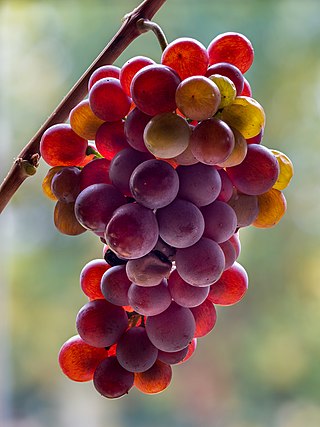
Pinot Gris, Pinot Grigio or Grauburgunder is a white wine grape variety of the species Vitis vinifera. Thought to be a mutant clone of the Pinot Noir variety, it normally has a grayish-blue fruit, accounting for its name, but the grapes can have a brownish pink to black and even white appearance. The word pinot could have been given to it because the grapes grow in small pinecone-shaped clusters. The wines produced from this grape also vary in color from a deep golden yellow to copper and even a light shade of pink, and it is one of the more popular grapes for skin-contact wine.

German wine is primarily produced in the west of Germany, along the river Rhine and its tributaries, with the oldest plantations going back to the Roman era. Approximately 60 percent of German wine is produced in the state of Rhineland-Palatinate, where 6 of the 13 regions (Anbaugebiete) for quality wine are situated. Germany has about 103,000 hectares of vineyard, which is around one tenth of the vineyard surface in Spain, France or Italy. The total wine production is usually around 10 million hectoliters annually, corresponding to 1.3 billion bottles, which places Germany as the eighth-largest wine-producing country in the world. White wine accounts for almost two thirds of the total production.

Ridge Vineyards is a California winery specializing in Cabernet Sauvignon, Zinfandel, and Chardonnay wines. Ridge produces wine at two winery locations in northern California. The original winery facilities are located at an elevation of 2,300 feet on Monte Bello Ridge in unincorporated Santa Clara County in the Santa Cruz Mountains AVA, south of Los Altos, California and west of Cupertino, California. The other Ridge winery facilities are at Lytton Springs in the Dry Creek Valley AVA of Sonoma County. Ridge Vineyard's 1971 Monte Bello Cabernet Sauvignon gained prominence for its fifth-place finish in the 1976 "Judgment of Paris" wine tasting.

The wine industry of Ukraine is well-established with long traditions. Several brands of wine from Ukraine are exported to bordering countries, the European Union, and North America.
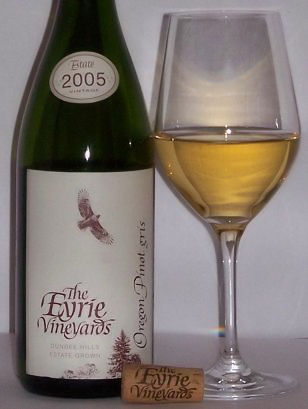
Wine has been produced in the United States since the 1500s, with the first widespread production beginning in New Mexico in 1628. Today, wine production is undertaken in all fifty states, with California producing 84 percent of all US wine. The North American continent is home to several native species of grape, including Vitis labrusca, Vitis riparia, Vitis rotundifolia, and Vitis vulpina, but the wine-making industry is based almost entirely on the cultivation of the European Vitis vinifera, which was introduced by European settlers. With more than 1,100,000 acres (4,500 km2) under vine, the United States is the fourth-largest wine producing country in the world, after Italy, Spain, and France.

Saperavi is an acidic, teinturier-type grape variety native to the country of Georgia, where it is used to make many of the region's most well-known wines. It is also grown in Russia and in lesser quantities in Armenia, Moldova, Ukraine, Uzbekistan, Azerbaijan, Australia.
Carmel Winery is a vineyard and winery in Israel. Founded in 1882 by Edmond James de Rothschild, its products are exported to over 40 countries. It is the largest winery in Israel, with a local market share of almost 50%.

New York wine refers to wine made from grapes grown in the U.S. state of New York. New York ranks third in grape production by volume after California and Washington. 83% of New York's grape area is Vitis labrusca varieties. The rest is split almost equally between Vitis vinifera and French hybrids.

B.R. Cohn Winery is a winery in Sonoma Valley, California in the United States.

Kazakh wine is wine made in Kazakhstan. The roots of the Kazakh wine industry can be traced to the 7th century AD when grapevines were brought to the region from neighboring Uzbekistan and China. While only around 4% of the land in Kazakhstan is ideally situated for viticulture, the country does manage to produce over 6.2 million gallons of wine annually from 32,120 acres (13,000 ha). Buoyed by its mineral wealth, the country is an enthusiastic consumer of wine but must import 80% of the 30 m bottles it drinks.


Vietnamese wine is wine produced in Vietnam. The area was first cultivated for viticulture during the French colonial rule of the region in the late 19th century. The region's tropical climate was ill-suited for the type of Vitis vinifera that the French colonists were used to and the wine industry turned its attention to fruit wine production. The late 20th century saw a renewed focus on the development of Vitis vinifera with the assistance of flying winemakers from regions like Australia. In 1995, a joint venture with Australian winemakers started an aggressive planting scheme to reintroduce international grape varieties like Cabernet Sauvignon and Chardonnay to land that was until recently littered with landmines left over from the Vietnam War.

Algerian wine is wine cultivated and bottled in Algeria. It has played an important role in the history of wine. Algeria's viticultural history dates back to its settlement by the Phoenicians and continued under the Roman empire. Prior to the Algerian War of Independence (1954-1962), Algeria was the largest wine exporter in the world, accounting for nearly two-thirds of the total international wine trade.

Slovenia has more than 28,000 wineries making between 80 and 90 million litres annually from the country's 22,300 ha of vineyards. About 75% of the country's production is white wine. Almost all of the wine is consumed domestically with only 6.1 million L a year being exported—mostly to the United States, Bosnia and Herzegovina, Croatia, and lately the Czech Republic. Most of the country's wine production falls under the classification of premium (vrhunsko) wine with less than 30% classified as basic table wine (namizno vino). Slovenia has three principal wine regions: the Drava Wine-Growing Region, the Lower Sava Wine-Growing Region, and the Littoral Wine-Growing Region.
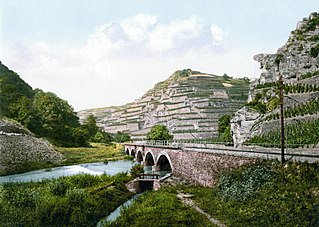
Ahr is a wine region (Anbaugebiet) for quality wine in Germany, and is located in the valley of the river Ahr, a tributary of Rhine, and is situated in the federal state of Rhineland-Palatinate. With only 558 hectares of vines as of 2008, it is one of smaller of Germany's 13 regions. Despite its northern location it primarily produces red wines, and red grape varieties account for 86% of the vineyard area, which is more than in any other German wine region.

Nova Scotia wine is Canadian wine produced in the Canadian province of Nova Scotia. Nova Scotia's wineries are primarily organized under the Wine Association of Nova Scotia, though not all wineries are members. The industry began in the late 1970s with the original Grand Pré Winery in the Annapolis Valley of Nova Scotia.

Mission Hill Family Estate is a wine grower and producer based in West Kelowna, British Columbia, Canada, in the Okanagan Valley wine region. The winery is situated atop Mission Hill overlooking a 145 kilometre lake, mountains and vineyards.

The Baja California wine industry is concentrated in a small area of the state of Baja California, Mexico. Most of the production is in the Valle de Guadalupe, there is also grape and wine production in some neighboring valleys. These valleys all have Mediterranean-type microclimates, instead of desert, thanks to sea breezes and fog which comes inland from the Pacific Ocean. Though a bit warmer and drier, the region produces many of the same grapes as in California, US, producing varietals that originated in southern France, Spain, Portugal, Italy and Greece.
